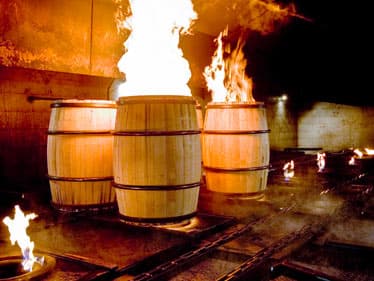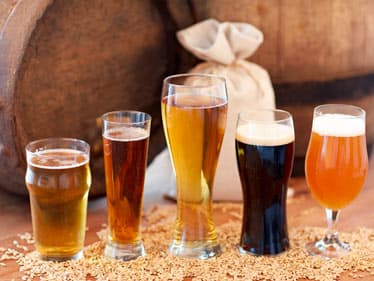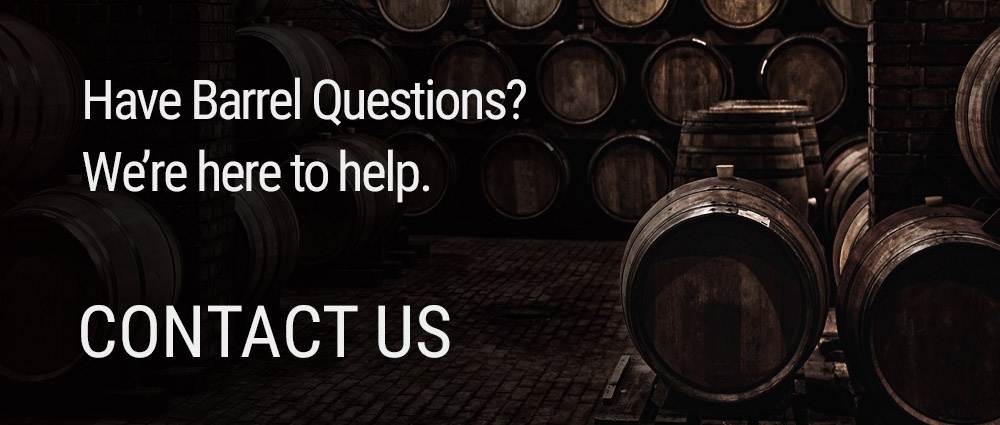Barrel aging may seem like a large undertaking, and in many ways it is. With so many different varieties and complexities within barrels, it’s easy to get overwhelmed and discouraged. But once you understand the ways barrel aging can improve taste and add exotic flavors, you won’t look back. Get more confident in your barrel knowledge and brush up on the barrel aging basics.
The Effects of Wood
 The type of wood/barrel you decide to use has a drastic effect on the final outcome in terms of color, profile, and flavors. Oak is the most popular wood used for barrel aging not only because of its leak-resistant grain formation but also because of its unique and flavorful contributions. Everything from the organic compounds in the wood to the level of char or toast of the barrel will have an impact. There are five main compounds found in oak that will lend important flavor notes, and getting to know them will give you more control over your aging program:
The type of wood/barrel you decide to use has a drastic effect on the final outcome in terms of color, profile, and flavors. Oak is the most popular wood used for barrel aging not only because of its leak-resistant grain formation but also because of its unique and flavorful contributions. Everything from the organic compounds in the wood to the level of char or toast of the barrel will have an impact. There are five main compounds found in oak that will lend important flavor notes, and getting to know them will give you more control over your aging program:
- Oak Lactones: The two main aroma constituents of raw oak, these lactones give a woody or coconut flavor.
- Vanillin: Just like it sounds, vanillin releases vanilla aromas with the degradation of wood cells.
- Furfural: Coming from heat during the toasting process, these compounds possess aromas of butterscotch, light caramel, and faint almond.
- Eugenol: Produces spicy, clove aromas from the air drying process.
- Guaiacol: The “charry”: compound releases smoky aromas and spicy characters.
How Different Barrels Change Flavor
The type of barrel you choose has great influence over the profiles that evolve as well. The first thing to think about is the barrel’s past. What aged in the barrel beforehand? How will that affect what you’re going to put in now? From red wine to sake, to cinnamon whiskey and everything in between, the possibilities are virtually endless. The flavor profiles that will evolve depend largely on what was in the barrel beforehand and how long you age in it. Aging in a rum barrel? Expect a range of flavors from coconut and molasses to notes of dark chocolate. Wine barrels? You’ll notice your beer will take on the subtle characteristics of the varietals of wine that aged in the barrel beforehand. Consider the pairing of what you want to age and the flavors that come with the barrel, but be open to experimentation.
Time in the Barrel
The flavors you will pick up from the barrel depend on how long you use it. The length of time you expose your product to wood can be just a couple of days, weeks, months, or several years; it all depends on the barrel, the product, and the profiles you’re looking for. A general rule of thumb is the greater the surface area of the wood, the quicker the flavors will evolve. Product sitting in a five-gallon barrel will pick up flavor much quicker than one sitting in a standard 53-gallon barrel, and the use of chips or cubes will also accelerate this process. This is important to remember so you don’t end up “over oaking” or overpowering other important characteristics and flavors. If you’re just looking to grab the bold flavors of the barrel, then a shorter timeline is good. If you want to pull more delicate notes out of the wood, you’re looking at a much longer aging time.
Styles of Beer That Age Well
 While almost all styles of beer have been experimented with (most successfully), there are a few tried and true pairings that the beer world has taken to:
While almost all styles of beer have been experimented with (most successfully), there are a few tried and true pairings that the beer world has taken to:
- Imperial Style Beers: Originally brewed with high ABV by the British to impress the Russians, it’s only natural these high-alcohol style beers get a little stronger with some barrel aging.
- Barleywines: Most barleywines are high-ABV and heavy on dark fruit flavors which complement the vanilla and woody flavors of an oak barrel, specifically bourbon and whiskey barrels, perfectly.
- Porters: With a natural earthy taste, porters take well to vanilla, chocolate, and even specialty flavors like pumpkin and fruit found in barrels. Bourbon barrels are the most common use of aging for porters.
- Sours: Barrel-aged sours often make use of the Brettanomyces yeast strain, which is more than capable of thriving in a wooden barrel, to achieve that tart taste. Fruit sours are also aged in barrels with their respective fruits to absorb the complex flavors.
Still have questions? Have no fear, we’re here to help. Contact us for any of your barrel questions, free barrel aging consulting, or to order a barrel today!


